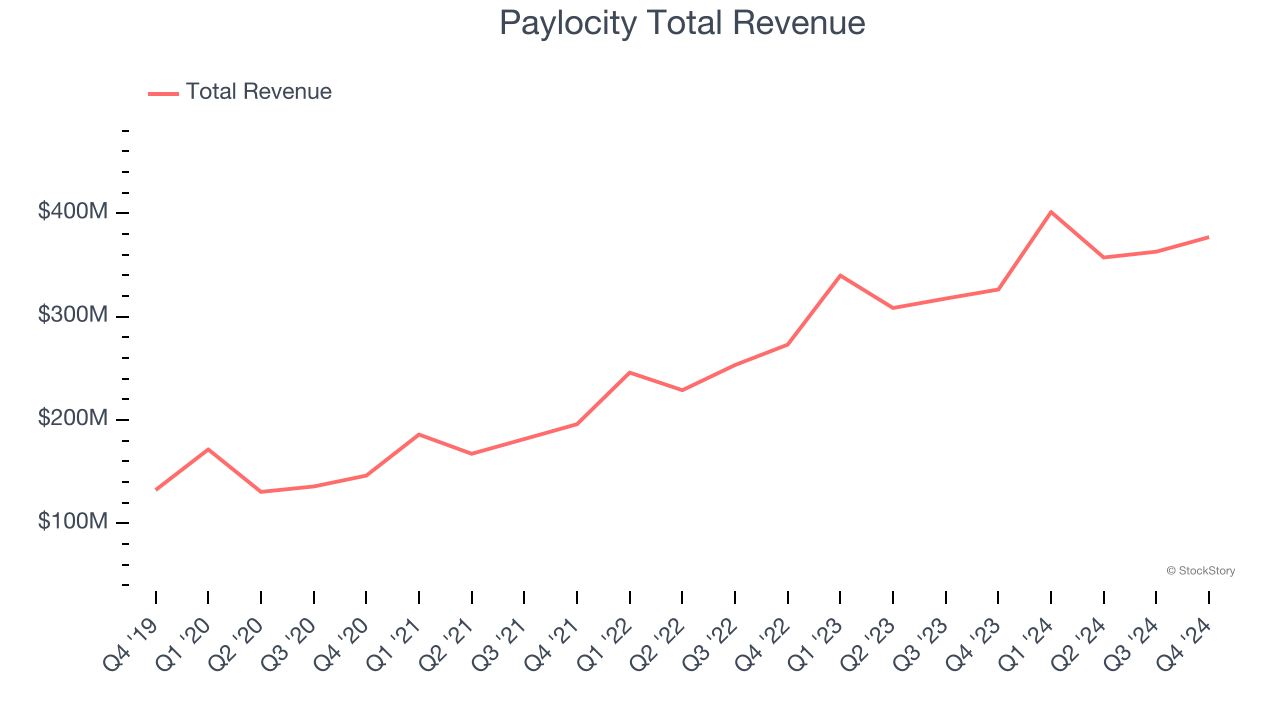Unpacking Q4 Earnings: Paycor (NASDAQ:PYCR) In The Context Of Other HR Software Stocks

As the craze of earnings season draws to a close, here’s a look back at some of the most exciting (and some less so) results from Q4. Today, we are looking at hr software stocks, starting with Paycor (NASDAQ: PYCR).
Modern HR software has two powerful benefits: cost savings and ease of use. For cost savings, businesses large and small much prefer the flexibility of cloud-based, web-browser-delivered software paid for on a subscription basis rather than the hassle and complexity of purchasing and managing on-premise enterprise software. On the usability side, the consumerization of business software creates seamless experiences whereby multiple standalone processes like payroll processing and compliance are aggregated into a single, easy-to-use platform.
The 6 HR software stocks we track reported a mixed Q4. As a group, revenues beat analysts’ consensus estimates by 1.5% while next quarter’s revenue guidance was 4% below.
While some hr software stocks have fared somewhat better than others, they have collectively declined. On average, share prices are down 3.6% since the latest earnings results.
Paycor (NASDAQ: PYCR)
Founded in 1990 in Cincinnati, Ohio, Paycor (NASDAQ: PYCR) provides software for small businesses to manage their payroll and HR needs in one place.
Paycor reported revenues of $180.4 million, up 13.1% year on year. This print exceeded analysts’ expectations by 1.9%. Despite the top-line beat, it was still a slower quarter for the company with a significant miss of analysts’ EBITDA estimates.

Interestingly, the stock is up 1.6% since reporting and currently trades at $22.49.
Read our full report on Paycor here, it’s free.
Best Q4: Paylocity (NASDAQ: PCTY)
Founded by payroll software veteran Steve Sarowitz in 1997, Paylocity (NASDAQ: PCTY) is a provider of payroll and HR software for small and medium-sized enterprises.
Paylocity reported revenues of $377 million, up 15.5% year on year, outperforming analysts’ expectations by 2.7%. The business had a strong quarter with an impressive beat of analysts’ EBITDA estimates and full-year EBITDA guidance beating analysts’ expectations.

Paylocity scored the biggest analyst estimates beat and highest full-year guidance raise among its peers. Although it had a fine quarter compared its peers, the market seems unhappy with the results as the stock is down 10.4% since reporting. It currently trades at $189.82.
Is now the time to buy Paylocity? Access our full analysis of the earnings results here, it’s free.
Weakest Q4: Dayforce (NYSE: DAY)
Founded in 1992 as Ceridian, an outsourced payroll processor and transformed after the 2012 acquisition of Dayforce, Dayforce (NYSE: DAY) is a provider of cloud based payroll and HR software targeted at mid-sized businesses.
Dayforce reported revenues of $465.2 million, up 16.4% year on year, exceeding analysts’ expectations by 2%. Still, it was a weaker quarter as it posted full-year guidance of slowing revenue growth and revenue guidance for next quarter missing analysts’ expectations significantly.
Dayforce delivered the weakest full-year guidance update in the group. As expected, the stock is down 20.5% since the results and currently trades at $57.04.
Read our full analysis of Dayforce’s results here.
Paychex (NASDAQ: PAYX)
One of the oldest service providers in the industry, Paychex (NASDAQ: PAYX) offers its customers payroll and HR software solutions.
Paychex reported revenues of $1.51 billion, up 4.8% year on year. This number was in line with analysts’ expectations. Aside from that, it was a mixed quarter as its performance in some other areas of the business was disappointing.
Paychex had the slowest revenue growth among its peers. The stock is flat since reporting and currently trades at $144.73.
Read our full, actionable report on Paychex here, it’s free.
Asure (NASDAQ: ASUR)
Created from the merger of two small workforce management companies in 2007, Asure (NASDAQ: ASUR) provides cloud based payroll and HR software for small and medium-sized businesses (SMBs).
Asure reported revenues of $30.79 million, up 17.2% year on year. This print met analysts’ expectations. However, it was a slower quarter as it logged EBITDA guidance for next quarter missing analysts’ expectations significantly and a slight miss of analysts’ EBITDA estimates.
Asure delivered the fastest revenue growth but had the weakest performance against analyst estimates among its peers. The stock is down 2.8% since reporting and currently trades at $9.42.
Read our full, actionable report on Asure here, it’s free.
Market Update
The Fed’s interest rate hikes throughout 2022 and 2023 have successfully cooled post-pandemic inflation, bringing it closer to the 2% target. Inflationary pressures have eased without tipping the economy into a recession, suggesting a soft landing. This stability, paired with recent rate cuts (0.5% in September 2024 and 0.25% in November 2024), fueled a strong year for the stock market in 2024. The markets surged further after Donald Trump’s presidential victory in November, with major indices reaching record highs in the days following the election. Still, questions remain about the direction of economic policy, as potential tariffs and corporate tax changes add uncertainty for 2025.
Want to invest in winners with rock-solid fundamentals? Check out our Top 5 Quality Compounder Stocks and add them to your watchlist. These companies are poised for growth regardless of the political or macroeconomic climate.
Join Paid Stock Investor Research
Help us make StockStory more helpful to investors like yourself. Join our paid user research session and receive a $50 Amazon gift card for your opinions. Sign up here.
More News
View More




Recent Quotes
View More
Quotes delayed at least 20 minutes.
By accessing this page, you agree to the Privacy Policy and Terms Of Service.